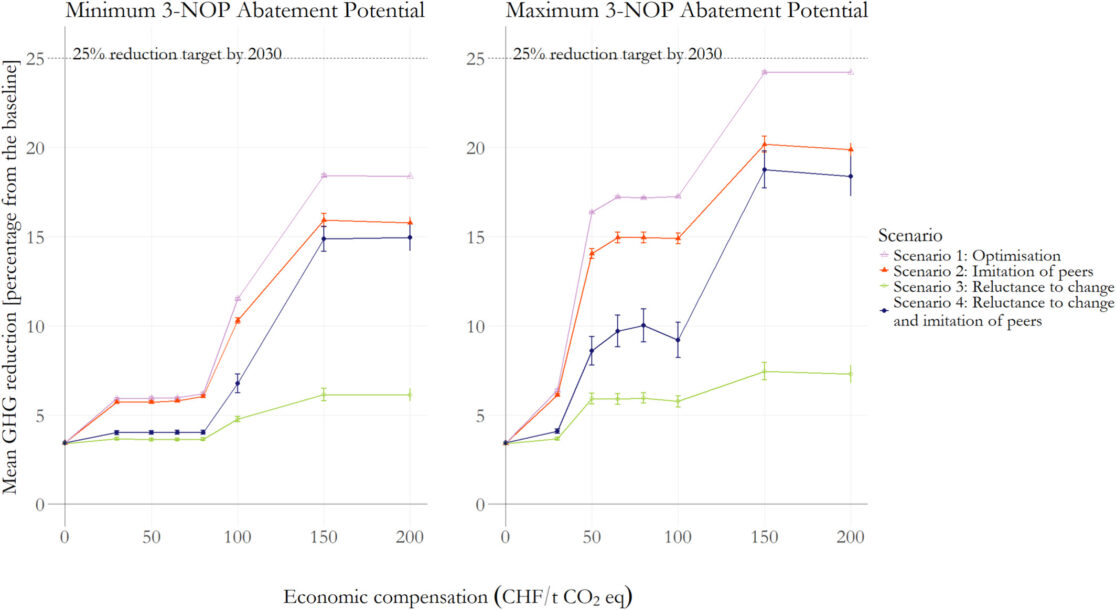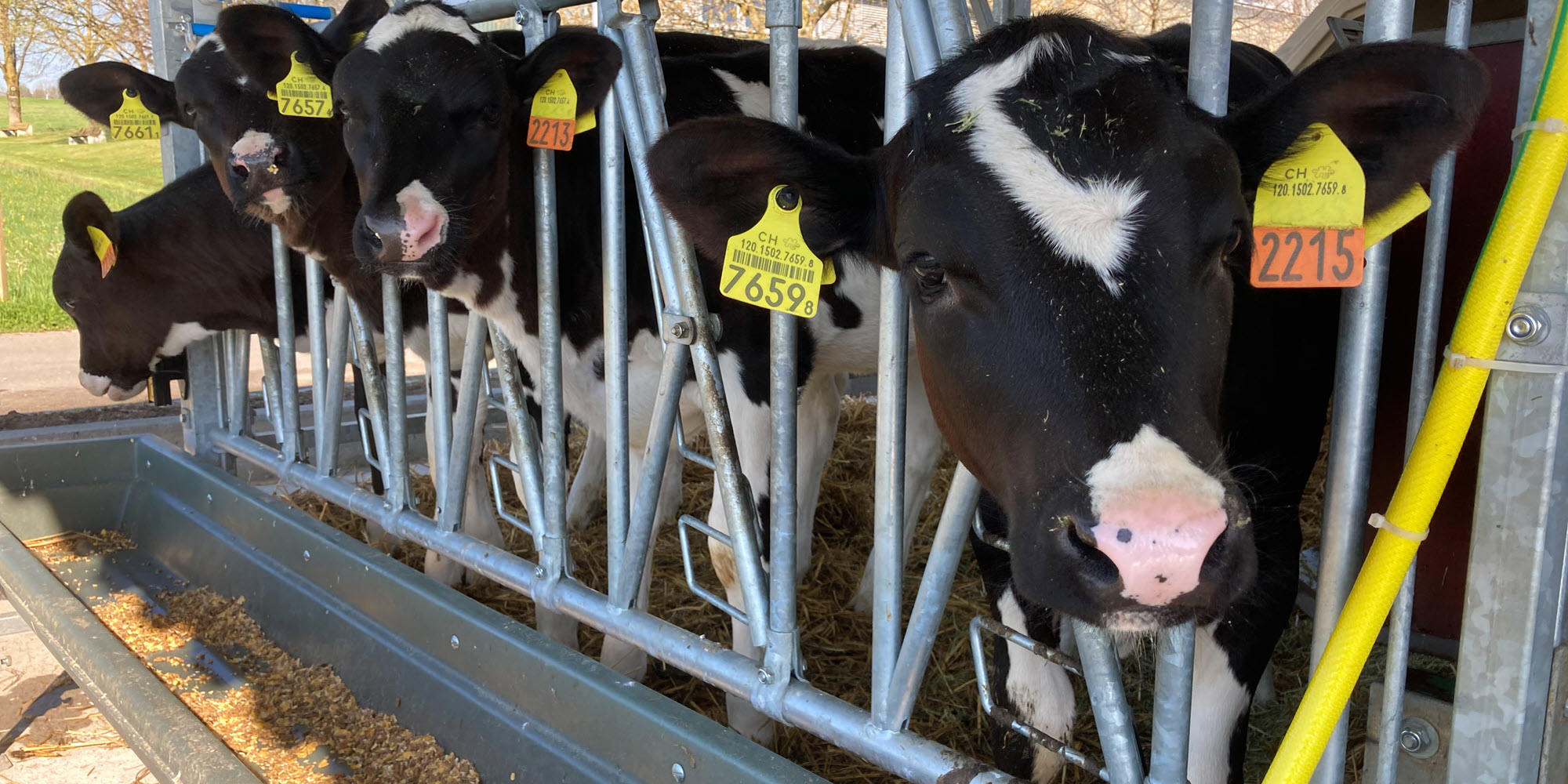How Voluntary Climate Protection Measures Can Be Successful
Photo: Johann Marmy,
Agroscope
Private initiatives such as carbon credit trading can support public policies aimed at reducing greenhouse gas emissions. Agroscope and ETH Zürich examined factors which influence the effectiveness of such initiatives.
The Swiss Climate Strategy 2050 emphasises the importance of private initiatives in achieving climate targets and urges all stakeholders in the value chain to take responsibility through their own actions. As a result, private stakeholders such as the Swiss producer cooperatives Mooh and Fenaco have launched schemes to offer carbon credits to farmers. Since participation in these private initiatives is voluntary, in addition to cost-benefit considerations, behavioural economic factors such as a reluctance to change or a desire to imitate colleagues play an important role in estimating the reduction potential of these carbon credits.
Modelling four behavioural scenarios
The agent-based model FARMIND developed by ETH Zürich was used to assess the impact of behavioural economic factors. It simulates farmer behaviour derived from purely profit-driven decisions and is based on interviews and surveys with 49 dairy and beef farmers in the Zürcher Flaachtal.
The study used the model to examine the contribution of two practice-based and easily controllable climate mitigation measures: using the feed additive 3-NOP (the active ingredient in the commercial product Bovaer) and substituting bought-in concentrates with farm-grown legumes. Four scenarios with different behavioural patterns were simulated to evaluate the impact of behavioural factors on the uptake of the greenhouse gas (GHG) mitigation measures – and thus on their success.
- Scenario 1 (optimisation) assumes that farmers adopt purely profit-maximising strategies and serves as a reference to understand the impact of behavioural factors.
- Scenario 2 (imitation) assumes that farmers are inclined to adopt climate mitigation measures successfully implemented by other farmers in their social network.
- Scenario 3 (reluctance to change) models the tendency among farmers to stick to familiar practices without being influenced by their colleagues or maximising their profits.
- Scenario 4 (combined) combines the imitation of colleagues (Scenario 2) with reluctance to change (Scenario 3). This scenario takes into account specific empirical information about risk preferences and how sensitively farmers respond to changes made by colleagues in their social network.
Carbon credit prices ranging from zero to 200 Swiss francs were simulated for each scenario. By comparing the different scenarios, it was possible to estimate the overall GHG reduction potential relative to a pure profit maximisation strategy, and the impact of different pricing levels.
Imitating proven measures increases the GHG reduction potential
The results show that when profit-driven behaviour alone is considered, a carbon payment of 150 CHF could reduce emissions by up to 24% based on the maximum reduction potential of the feed additive 3-NOP (see Figure). However, when reluctance to change is taken into account, the reduction potential drops dramatically to just 7%.
When social effects through the imitation of successful adopter are considered, the results improve compared with the pure profit optimisation scenario, increasing the GHG mitigation potential to 19% in the simulations.
Maximum greenhouse gas reductions are achieved with a carbon credit price of 150 CHF per tonne of CO₂ equivalent. The potential for further GHG reductions stagnates at higher prices levels.
Private-sector initiatives support public climate mitigation policies
The simulations show that behavioural factors must be considered in addition to profit maximisation when evaluating the potential of private-sector initiatives – carbon credits in this case – to reduce greenhouse gas emissions. In this study, the behavioural factors under consideration reduce the reduction potential, although private-sector initiatives alone would not achieve the proposed targets of the Swiss Climate Strategy, which aims to reduce agricultural emissions by 25 per cent from 1990 levels by 2030 (see dotted line in Figure 1). Nonetheless, private-sector initiatives play a crucial role and support public climate mitigation measures.

Conclusions
- Feed additives such as 3-NOP (Bovaer) or substituting bought-in concentrates with farm-grown legumes can contribute to reducing greenhouse gas emissions without impacting production levels.
- Private-sector initiatives such as carbon credits can help to achieve emission targets by making the adoption of technical measures more attractive to farmers.
- When evaluating the potential of greenhouse gas reduction measures, behavioural factors such as reluctance to change must be considered. The assumption that decision-making is driven purely by profit maximisation overestimates the reduction potential.
- Social networks which enable farmers to share information about successful climate mitigation measures increase the potential of voluntary credits to reduce greenhouse gas emissions. Integrated strategies which combine private-sector initiatives (such as carbon credits) with public policies (such as supporting adapted livestock production methods and systems) are essential to reduce agricultural GHG emissions.
Bibliographical reference
Understanding Farmer Behaviour for Successful Climate Change Mitigation in Voluntary Initiatives.



